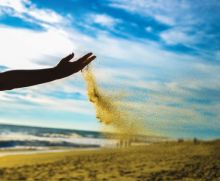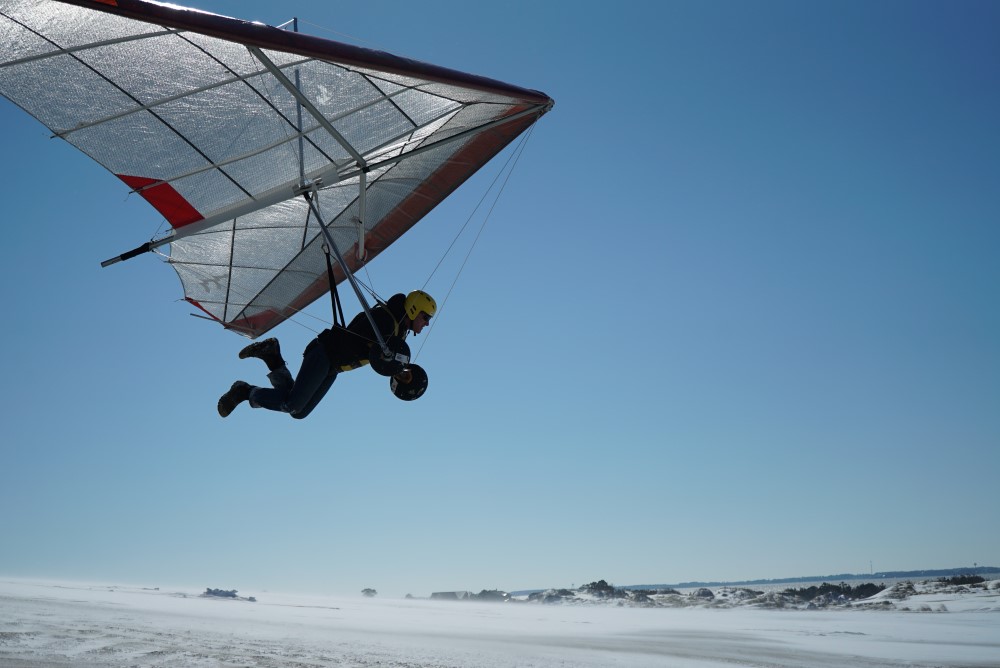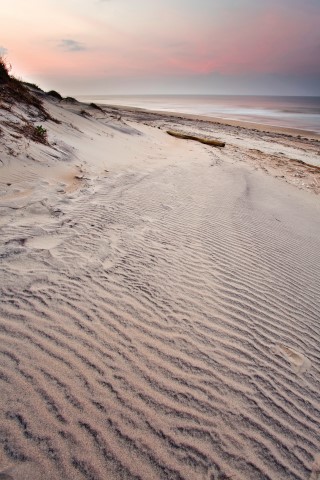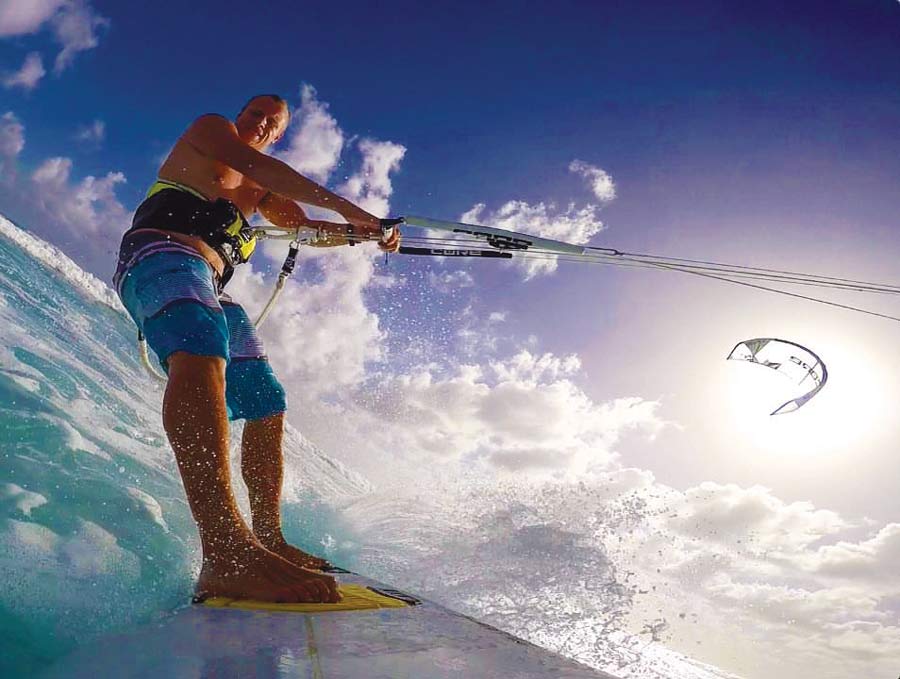
How Outer Banks lives are affected by and dependent on the wind.
When I was growing up in central North Carolina, daily wind speed and direction were the farthest things from my mind. I didn’t think about the wind unless it was cold and uncomfortable, and to be quite honest, direction didn’t matter because I had no idea where north was, let alone south, east or west.
Moving to Nags Head 25 years ago changed that, giving me a footing on Earth and a connection to the elements for the first time in my life. Compass directions became important, and I learned very quickly how much the wind affects the shape of an Outer Banks day.
Now the first thing I do when I wake up in the morning is look out the window toward the sound. With just a glance at the color, movement and condition of the water, along with my neighbor’s bright red flag, I detect wind direction and approximate speed, which gives me information about my forthcoming activities. If the sound water is dark blue with a brown hue and moving toward me, it’s blowing southwest, and I know it will be a warmer day, perfect for a run. If the sound water is moving away from shore, it’s blowing northeast or southeast, and I know the ocean is going to be warm for swimming. If I see whitecaps headed from the northwest in the winter, I cringe and fight the urge to crawl back into bed; the cold northwest wind blows right through the walls of my old house. On those rare days when the wind is light and the sound is slick calm, the same color as the sky, my dog and I skip the run and jump on the standup paddleboard instead.

The wind affects my daily life in small ways, altering little decisions like whether to go fishing in the boat or riding waves at the beach, to put extra blankets on the beds or to open the windows. But for many Outer Bankers the wind affects livelihoods, and during storms it affects lives. That’s why the local radio station has a wind report in the mornings and why so many Outer Banks residents are weather geeks and back-seat forecasters, their phones filled with crystal ball-like weather apps that precisely monitor and predict the wind conditions right down to the minute. And that’s why people whose daily lives depend on the wind have developed a sixth sense that could only be honed with experience. One thing I’ve learned is that when storms are coming, these are the people to go to. The seasoned fisherman and kiteboarder in my neighborhood are always right.
I’m fascinated by this invisible force of nature and the way it consumes our lives and conversations. Wind is just airflow caused by the uneven heating of the earth, pockets of warm and cold air colliding, yet it defines lives, human and animal, and our environment. Inevitably all of our conversations turn to this movement of air. We talk about what the wind is doing and what it’s going to do. We snap to attention when the wind switches. We know which exact wind direction and speed floods our village or street. And we get an eerie feeling when the wind dies out, causing an almost unsettling quiet and stillness.
Wind plays a starring role in our memories – those dramatic seven-day nor’easters, those perfect barrels groomed by offshore winds and those epic beach days in a light east wind stand out in our minds. And it affects our moods. East winds bring a clarity and crispness to the air that’s refreshing and energizing, while incessant humid southwest winds can be exhausting and wear on our nerves.

“We have no protection from raw weather here; we are too far out to sea,” writes Jan DeBlieu in her book Wind: How the Flow of Air Has Shaped Life, Myth, and the Land. “There is nothing between the coast and Appalachian Mountains, hundreds of miles inland, to brake the speed of building westerly breezes. There is nothing between the Outer Banks and Africa to dampen the force of easterly blows.”
Interestingly, scientists who study such things have noted that dry, hot winds contain positively charged ions, which results in human irritability, hence the term “ill wind.” I have a theory, which I’ve yet to substantiate, that east winds coming right off the ocean are richer in negative ions, which are proven to make us feel more sedate and happy.
According to iKitesurf.com, the Outer Banks averages 20 days a month of windy days all year round. Long ago there were as many as 45 windmills taking advantage of this abundance of wind; in modern times we have a few turbines that harvest the wind for power, but many of us hope there will one day be more. Spring and fall have a reputation for stronger winds, but summer winds are generally consistent on a daily basis. In summer, the prevailing winds are usually from the southwest. By fall, southwest winds are replaced by northwest and northeast winds. North winds are prevalent in winter, while spring gets a mix of southwest and northeast winds with some northwest. In summer of 2018, a lot of the wind chatter was about the oddity of the prevailing southeast winds, in addition to an abnormally large number of days with just no wind at all.
On the Outer Banks people have their favorite wind conditions and directions for a variety of reasons. People who participate in different sports or who have outdoor jobs always have an ideal wind setup. It takes time and experience to understand wind patterns and their effects on different activities. Definitely the most complicated example of that is fishing. It can take a lifetime to learn which wind is good or bad in which location and for which fish, but when your livelihood depends on it, you learn quickly and commit it to memory.

“Wind is pretty much my whole life,” says Wanchese commercial fisherman John Silver. “I think about it all the time. Even when I’m trying not to think about it, I actually am.”
Local lifeguards must watch the wind closely as well. “If you look at wind speed, wind direction, swell and tide, you can figure out the upcoming hazards of the day pretty quickly,” says Dave Elder, the supervisor of Kill Devil Hills Ocean Rescue. “Any wind above 15 to 17 mph, things happen more rapidly.”
Many businesses exist on the Outer Banks solely because of the wind, and Kitty Hawk Kites is the prime example of that. Founder John Harris established his hang-gliding school here for the same reasons the Wright brothers conducted flying experiments here: wind and dunes, which, he points out, were created by wind. “Wind is a huge factor in making the Outer Banks the recreation mecca that it is,” Harris says. “And to our business in particular, wind is at the core of our success every day.” Everything they offer, from hang-gliding and kiteboarding to kite-flying and boating, depends on the wind. Harris likes to note that without wind the Outer Banks wouldn’t be even here. “If you take the 30,000-foot view,” he says, “wind with sediment from Chesapeake Bay created the Outer Banks in the first place.”
Amy and Brian Klauser, owners of OceanAir Sports in Avon, are two other Outer Bankers who make a living off the wind. To offer their kiteboarding and windsurfing lessons on Pamlico Sound, southwest winds at 10 to 15 mph are the perfect conditions. And that’s great because July, when most of the people who need lessons are in town, consistently offers those conditions. But not this year. 2018 was an anomaly, offering northeast and southeast winds almost all month. Since weather is not dependable, diversification is the key at OceanAir Sports. This July’s conditions were perfect for Amy to teach SUP yoga and for them to rent kayaks, paddleboards and Jet skis.
“Our business revolves around the weather, so we are constantly looking at wind readings and apps and forecasts,” Brian says. “Almost every customer who walks through the door wants to know what it’s doing and what it’s going to do tomorrow, next week or next month. I’m constantly thinking about it because the speed and direction set the tone for what we’ve got going on every day.”
Bob Chestnut, owner of Ride the Wind Surf Shop in Ocracoke, thinks about wind too, and not always in a good way. “If the wind blows, no people come,” he says, fresh off Hurricane Florence with N.C. 12 closed due to ocean overwash and the Hatteras ferry not running. “Too much northeast wind messes up our road and access. The wind is the first thing we think about every day. Are the ferries going to run? Are people going to be able to get here? The wind affects the livelihood of the whole island.”
Everyone cannot be happy at once when it comes to wind. In stark contrast to those whose vacations are spoiled by too much wind – fishing trips canceled, red flags flying, umbrellas upended – there are those who come to the Outer Banks specifically for the wind, kiteboarders, windsurfers and hang gliders among them. For these people, hard-earned vacations are ruined by a lack of wind. For every surfer craving an offshore wind, there’s a fisherman wishing for an onshore wind. Yet when a gale- or hurricane-force wind blows, we all come together in the hope that it’s short-lived and non-damaging. And as everyone knows, on the Outer Banks it won’t be long until the wind switches again.

Most everyone on the Outer Banks has their favorite wind conditions, the perfect wind setup for their activities and vocations. We asked a few locals to share theirs.
Jerry Slayton, surfer, Nags Head:
I like a nor’easter for three days and then a shift to the southwest. That’s ideal. Cleans up the surf and makes it nice.
Bob Chestnut, surfer, Ocracoke:
Northwest. Our whole beach faces southeast, so northwest wind is offshore. Offshore winds hold the wave faces
up nice.
John Silver, commercial fisherman, Wanchese:
Anything but southeast. Northwest wind is my favorite; it’s best for comfort and fishing. A hard wind shift is really good for fishing too.
Brian Klauser, kiteboarder, Avon:
I love strong northeast wind, 20 to 30 mph, at the lighthouse in Buxton. In those conditions I’ll lock the door at the shop and go.
John Harris, hang-gliding school owner, Nags Head:
Ideal for us is 10 to 15 mph out of the northeast or east.
Ryan Rhodes, kayak fisherman and surfer, northern Outer Banks:
Light east or southeast because it makes for clear and slick water. In fishing, southwest is southworst, but the waveriding part of me likes a light southwest.
Dave Elder, lifeguard, Kill Devil Hills:
Personally, I like winds from the north/northeast because the water is warm and clear and the air is cool and less humid. Professionally, we like onshore winds (northeast or southeast). Offshore winds have us chasing floats and rescuing paddleboarders.
Pam Malec, spearfisher and scuba diver, northern Outer Banks:
I want it to be light east, 0 to 5 mph. That direction pushes the warm Gulf Stream waters closer, and the light wind makes for light waves, which means the best visibility.
Georgia Beach, seaglass seeker, northern Outer Banks:
I love to go looking right after a hard northeast wind.
Vic Berg, waterfowl hunter, around Oregon Inlet:
Heavy nor’easter up to 40 and 45 or more, but 25 to 30 is the best. A nor’easter means weather is deteriorating and ducks get wound up. That’s when the weather’s just ducky.
Capt. Mark Fann, offshore charter captain, Wanchese:
A stable southeast is best. It helps set up the weed lines. Slick calm is the worst, it’s good for boating but not fishing. You need something to give a chop on the water.
Brian Patteson, seabird charter captain, Hatteras:
Shifting winds. Too much of the same wind is no good for us, particularly a long run of southwest. We need light to moderate easterlies to give us the most diversity of birds because they come in from hundreds of miles offshore.
Mike Preziotti, pier fisherman, Jennette’s Pier, Nags Head:
My favorite is a little bit of northeast, east-northeast about 10 to 15 mph, for puppy drum and flounder. For trout I want a southwest wind. When I wade in the sound, I want a west or southwest wind.
Amy Klauser, SUP yoga instructor, Nags Head:
Light winds out of the east are perfect.


 Molly Harrison is managing editor at OneBoat, publisher of OuterBanksThisWeek.com. She moved to Nags Head in 1994 and since then has made her living writing articles and creating publications about the people, places and culture of the Outer Banks.
Molly Harrison is managing editor at OneBoat, publisher of OuterBanksThisWeek.com. She moved to Nags Head in 1994 and since then has made her living writing articles and creating publications about the people, places and culture of the Outer Banks.




